Flashback to the Bunker: Reframing Echoes of Captivity in Unbreakable Kimmy Schmidt
by Charity Fox
Published September 2019
Abstract:
This article will explore how the Netflix original television series Unbreakable Kimmy Schmidt (2015-2019) uses atemporal storytelling techniques within a campy, comedic aesthetic to reframe audience expectations of captivity narratives. Kimmy’s flashbacks to the bunker serve two main narrative functions: 1) help Kimmy use a past lesson to solve her present dilemma; and 2) provide audiences with a comical yet jarring reminder that Kimmy was held captive and abused for fifteen years. I argue that the narrative construction of UKS tightly controls the echoes of Kimmy’s captivity, inviting audiences only into the memories of resilience that Kimmy curates for herself and refusing the potential for viewers to indulge in voyeurism or catharsis, while campy exaggerations work to further dethrone the serious subject material. The series challenges viewers’ entitlement to and relationship with the traumatic details of captivity survival, ultimately inviting viewers into a more complex relationship with captivity survivors.
Unbreakable! They alive, dammit! Females are strong as hell.
(Unbreakable Kimmy Schmidt Opening Theme)
The Netflix original television series Unbreakable Kimmy Schmidt (2015-2019) employs atemporal storytelling techniques within a campy, comedic aesthetic to reframe audience expectations of captivity narratives. This article will explore how UKS invites audiences to engage with its intrinsic norms as well as how it uses formal narrative structures to (re)direct and (re)orient audience attention to its subject. Unlike its immediate contemporaries, independent film Room (2015) and the BBC television series Thirteen (2016), UKS obscures details about abuse during captivity from viewers, refusing audiences the possibility of using female trauma for voyeuristic pleasure or cathartic release. Of course, Kimmy Schmidt carries scars from her captivity, but rather than focusing on the traumatic events of the bunker, UKS integrates Kimmy’s bunker memories in her diegetic present as echoes from her past that surface as carefully constructed narrative sequences. The tightly controlled narrative construction of UKS withholds lurid details of Kimmy’s trauma during captivity, inviting audiences only into the memories of resilience in the bunker that Kimmy curates for herself, which ultimately challenges viewers’ expectations of the captivity narrative genre.
A serialized story released one season at a time through a digital-streaming platform, UKS falls into the category of twenty-first century “complex television” identified by Jason Mittell. Complex television uses a range of serial techniques and “formal innovations” such as “real-time narration, atemporality, or reflexive storytelling” (52) to weave “a cumulative narrative that builds over time, rather than resetting back to a steady-state equilibrium at the end of every episode” (18). Mittell proposes that such narrative complexity “invites audiences to engage actively [with the series] at the level of form… Many of these programs outright demand such a level of engagement” (emphasis in original, 52). Creating a complex television program like UKS is a highly collaborative process that Mittell terms “authorship by management” (88). Rather than filling the traditional literary role of “author,” executive producers Tina Fey and Robert Carlock function as leaders overseeing the work of a “sustained team of creative and technical crew” (89). Instead of discussing implied or explicit authorial intentions, then, I follow David Bordwell’s suggestion to privilege the narrational processes of a finished filmed product as the source of storytelling agency itself (62). Additionally, UKS itself frequently draws audience attention to the importance of narrative construction and control, as Kimmy consciously tries to control the ways that others access and use her story.
UKS opens with the rescue of Kimmy Schmidt (Ellie Kemper), who was kidnapped at fourteen by Reverend Richard Wayne Gary Wayne (Jon Hamm) and held in a bunker in Durnsville, Indiana for fifteen years with three other women. The familiar milestones in a captivity narrative (kidnapping, captivity, rescue, and return) are quickly dispensed. In a four-minute opening sequence, UKS establishes Kimmy’s life during captivity and the media whirlwind around her rescue through an auto-tuned viral video (Unbreakable Kimmy Schmidt Opening Theme), culminating in a television interview with “The Indiana Mole Women.”

Dismissed from the studio with a condescending “Thank you, victims,” Kimmy suddenly declares, “I’m not going back! I’m staying here!... I have to get my life back. Everybody in Durnsville is always going to look at me like I’m a victim. And that’s not what I am!” (“Kimmy Goes Outside!” 00:04:20-05:00). Determined to escape permanent victim status, Kimmy builds a new life for herself in New York and a chosen family from her flamboyantly outrageous roommate Titus Andromedon (Tituss Burgess), surly landlord Lillian Kaushtupper (Carol Kane), and narcissistic employer/friend Jacqueline White (Jane Krakowski).
In the series’ first season, Kimmy hides her past while she experiences the “firsts” she missed in captivity, only breaking her anonymity to testify against the Reverend. In Season 2, Kimmy begins therapy, eventually confronting her absentee mother and her own anger at captivity. In Season 3, Kimmy goes to college and explores whether and how she should tell others about her past. In Season 4, Kimmy realizes she benefits from privileges alongside her traumas. She is frequently asked to share her story, but only on others’ terms. She is pursued by a publisher who wants her to write a captivity memoir titled Tubes of Terror: The Super Sad Story of Kimmy Schmidt by Kimmy Schmidt.
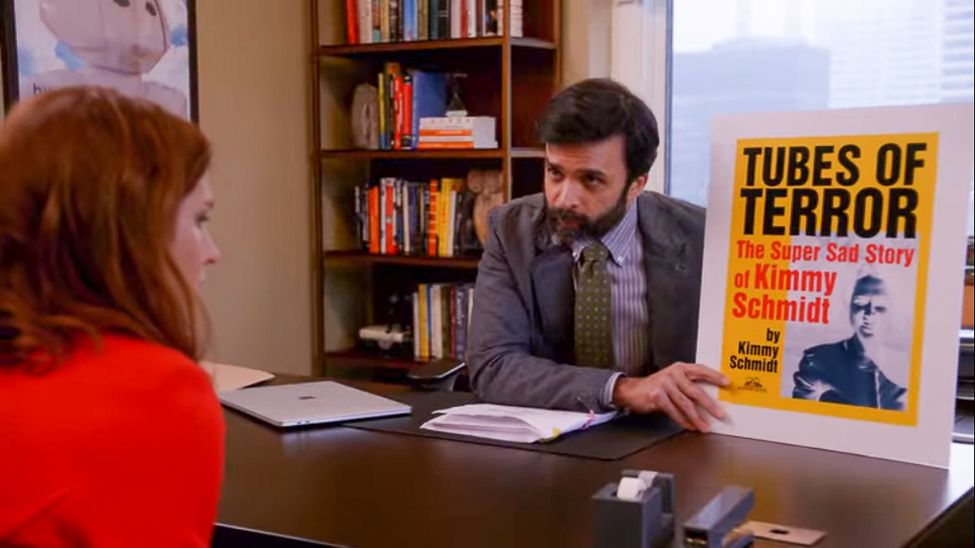
Instead, Kimmy decides to write a children’s book that will help readers (especially boys) avoid becoming monsters like the Reverend later in life. Published under K. C. Schmidt, The Legends of Greemulax becomes an international bestseller. In an intertextual extension beyond UKS’s immediate storyworld, the publisher Little, Brown Books for Young Readers released a real children’s novel titled The Legends of Greemulax in April 2019, credited to authors Kimmy Schmidt and Sarah Mlynowski. The Netflix series ends with Kimmy opening a Greemulax World at Universal Studios and meeting young fans who tells her, “Miss Schmidt, your books make me feel safe” (“Kimmy Says Bye!” 00:35:35-45).

Mittell argues that a complex television series establishes its intrinsic norms in early episodes, providing viewers “an immediate invitation to watch [the series] in a particular way” (56) and “teaching viewers how to watch and what to expect from future episodes” (168). A vital intrinsic norm established in the very first episode is that UKS intentionally engages with dark material through absurdist comedy and high camp. In “Notes on Camp,” Susan Sontag argued that camp sensibility exhibits a “love of the exaggerated, the ‘off,’ of things-being-what-they-are-not” (518). Sontag posits that the campy characters are in “a state of continual incandescence—a person being one, very intense thing,” an incredibly apt description easily applied to Kimmy (determined optimist), Titus (diva), Jacqueline (social climber), and Lillian (old-school New Yorker) (525). For Sontag, “The whole point of Camp is to dethrone the serious. Camp is playful, anti-serious. More precisely, Camp involves a new, more complex relation to ‘the serious.’ One can be serious about the frivolous, frivolous about the serious” (527). UKS employs camp aesthetics intensely, exaggerating everything to the point that it forces audiences to see the stereotypes they hold about captivity survivors and other social groups as both ridiculous and damaging. UKS used the lightness of camp to place viewers in an unexpected relationship with the dark subject of captivity.
Along with the exaggerations of high camp, UKS quickly establishes the use of atemporal storytelling techniques as series intrinsic norms. UKS uses diegetic retelling and flashbacks to control the audience’s access to the details of Kimmy’s time in captivity, narrative strategies that challenge viewers’ entitlement to and relationship with the “serious” details of captivity survival. According to Mittell, diegetic retelling is a narrative technique that “integrate[s] past events into a naturalistic style of moving-image storytelling” (183). Kimmy does not discuss details about her bunker abuses, but she does occasionally discuss coping methods she used in order to demonstrate her resiliency while helping others cope. Even then, she shares only the lesson learned, not how she learned it. One practice is counting to ten repeatedly, because “I learned a long time ago that a person can stand just about anything for ten seconds… All you’ve got to do is take it ten seconds at a time” (“Kimmy Gets a Job!” 00:10:35-11:30). Another method she discusses is her habit of creating all-encompassing fantasy worlds with her purple backpack/imaginary friend Jan S. Port (“Kimmy Meets an Old Friend!”). In a session with her therapist Andrea (Tina Fey), Kimmy reveals her primary strategy for coping with anger during a diegetic retelling: “In the bunker, I realized I was a Disney princess. I was held prisoner by a beast, like Belle. I had to keep my mouth shut like Ariel… But they [princesses] all had happy endings. So whenever my noodle got steamed, I just took a trip to my happy place” (emphasis in original, “Kimmy Goes to Her Happy Place!” 00:13:30-14:10). The visual scene shifts, taking audiences into Kimmy’s fantasy happy place, a classically animated segment where Princess Kimmy sings about burying her feelings deep inside while dancing with animals in a bucolic forest.
When I’m feeling sad or mad / and wish that I were dead, / I hide inside my mind and sing / a happy song instead. / Ding-dong diddly, ding-dong doo. / Just sing your anger away. / When the Reverend tries to terrorize / just cover up the screams and cries / with a ditty you improvise / over and over and every day. (“Kimmy Goes to Her Happy Place!” 00:14:10-15.25).
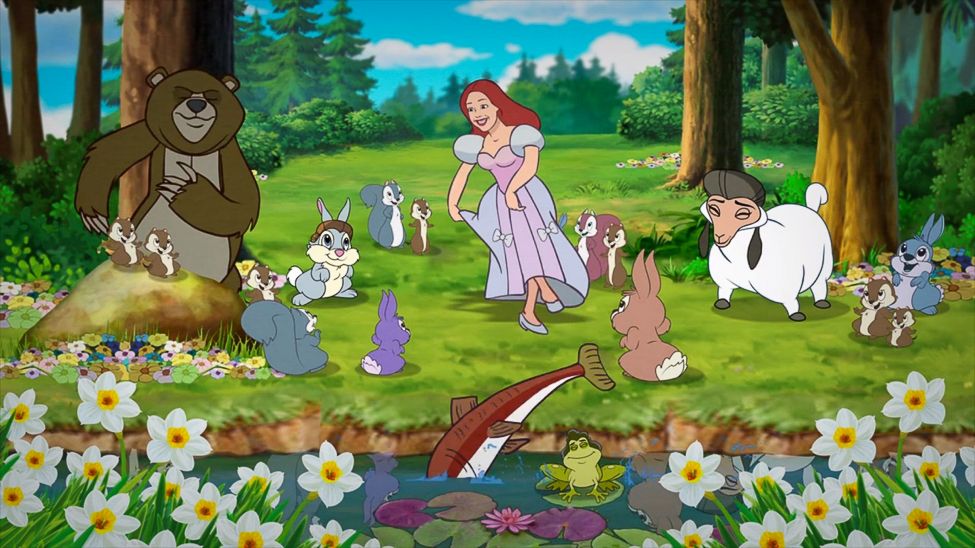
The sunny tune and cutesy animation magnify the campy darkness of the message. The overall effect of pasting a Disney princess narrative over a captivity narrative reinforces both Kimmy’s youth at the time of capture and the effectiveness of her mental efforts to reframe her experiences and memories. Later in this song, she refuses to share her bunker-mates’ fears, concerns, and confusion in captivity, at least partially because she has internalized the optimistic outlook of the Disney princess. It characterizes her protective impulses; princesses always protect their sidekicks, and those who persevere are guaranteed happy endings. Kimmy’s happy place fantasy also foregrounds her eventual turn as a children’s book author. As an adult, she realizes the influence stories can have on children’s interpretations of their world, and she uses The Legends of Greemulax to provide young readers with an alternative to damaging traditional patriarchal fables.
Though important in the overall series narrative, Kimmy’s diegetic retellings of bunker experiences are rarer than the scenes that audiences see through flashback sequences. In popular and clinical psychology, “flashbacks” are associated with posttraumatic stress disorder. The past decade has seen a broadened understanding that PTSD can be caused by a variety of violent or traumatic experiences, including sexual assault. In the latest edition of the Diagnostic and Statistical Manual of Mental Disorders (DSM-5, 2013), the American Psychological Association revised the diagnostic criteria for PTSD to include four diagnostic clusters: re-experiencing, avoidance, negative cognitions and mood, and arousal. According to the revised APA standards, “Re-experiencing covers spontaneous memories of the traumatic event, recurrent dreams related to it, flashbacks or other intense or prolonged psychological distress” (Posttraumatic Stress Disorder). This tracks with popular understandings of PTSD-style flashbacks. In her work on PTSD and suicide, Penny Coleman describes PTSD as characterized by “intrusions” of memory which function as “spontaneous reenactments of the traumatic event—the mind’s attempt to integrate an intolerable memory and establish a kind of psychic equilibrium” (4).
In narratology, a flashback or analepsis in literature “signals the retrospective evocation of an event, and may be internal (within the main narrative), external (pre-narrative), mixed or overlapping (prior to but continuing into the main narrative)” (Herman et al 591). There is a preference in literary narratology for using “analepsis” over “flashback” for this atemporal narrative technique to avoid connotations with psychology and visual media. However, I use “flashback” here intentionally to invoke those multiple connotations. Mittell points to flashbacks as one of several techniques that complex television series utilize to play with time for narrative effects. Flashbacks can remind viewers of past diegetic events in a complex television series, provide space for exploring characters’ backstories, or function as cutaway gags, visual and narrative asides that “cut away from the main action to comment on, illustrate, or refute whatever just happened in the story” (186-7).
Flashback sequences are consistently used throughout UKS to develop most characters’ backstories and provide fodder for cutaway jokes. Viewers learn about Jacqueline’s teenage yearning to live as a rich white person through her conversations with her Native American parents, Titus’ high school years as a popular but closeted jock in Mississippi, and Lillian’s former husband all through flashback sequences to their formative years. Kimmy’s bunker flashbacks occur most frequently in first two seasons, as she finds her footing in society and engages in therapy. Bunker flashbacks play a smaller (though no less pointed) narrative role in Seasons 3 and 4, as Kimmy’s world and experiences expand.
Jacqueline and Titus frequently remember things that made them “miserable” in their formative young adult years; usually integrated as a form a diegetic retelling, their flashbacks are understood as memories they explicitly share with Kimmy and the audience. Kimmy’s flashbacks are different from the other characters’, though. First, they are separate from her instances of diegetic retelling; in narrative context, this means that the flashbacks are shared with viewers but not usually with other characters. Second, Kimmy’s flashbacks highlight a very particular set of her memories that do not include “miserable” memories or lurid details of her captivity. She remembers the bunker as a place categorized by boredom, tedious tasks, interactions with female friends, and resistance, rather than a place of constant abuse and violation.
Kimmy’s flashbacks serve two main narrative functions: 1) help Kimmy use a past lesson to solve a present dilemma; and 2) provide audiences with a comedic yet jarring reminder that Kimmy was held captive and abused for fifteen years. In my analysis, I catalogued Kimmy’s bunker flashbacks into a typology of three main categories of flashbacks based on length and content: cutaway flashbacks, storyteller flashbacks, and re-experiencing flashbacks. In this typology, a cutaway flashback uses a quick flash of Kimmy’s memory from the bunker, usually lasting just a few seconds, to provide a punchline for a joke. Storyteller flashbacks are longer than cutaways and similar to a traditional analepsis. They usually tell a story about a time that Kimmy was challenged in the bunker and responded with strength and agency. Re-experiencing flashbacks occur when something in the diegetic present triggers a traumatic memory from the bunker for Kimmy. In response to the trigger, she experiences a PTSD-style flashback, but viewers do not join in her memories and can only watch her react to the memory within the diegesis.
The most frequently used flashbacks are cutaways that quickly highlight odd moments or positive interactions between Kimmy and her bunkermates. In one typical cutaway flashback sequence, Kimmy’s therapist Andrea asks her if she always puts others’ needs before her own. In response, Kimmy looks off in the distance, and the scene cuts away to a quick flash of memory of a time in the bunker when she did indeed prioritize others’ needs. Kimmy is shown wearing a fake beard and role-playing as the Reverend. She mimics his voice and insults the other women. She then allows Cyndee (Sara Chase) and Donna Maria (Sol Miranda) to punch, kick, and physically vent their rage at the Reverend onto her body. The scene cuts back to Kimmy and her therapist, where Kimmy admits that sometimes she might value others’ needs more than her own. (“Kimmy Meets a Drunk Lady!” 00:06:00-16). Absurd and funny, cutaway flashbacks to the bunker intentionally combine the punchline of a random joke with a gut-punching reminder of Kimmy’s long years of captivity.
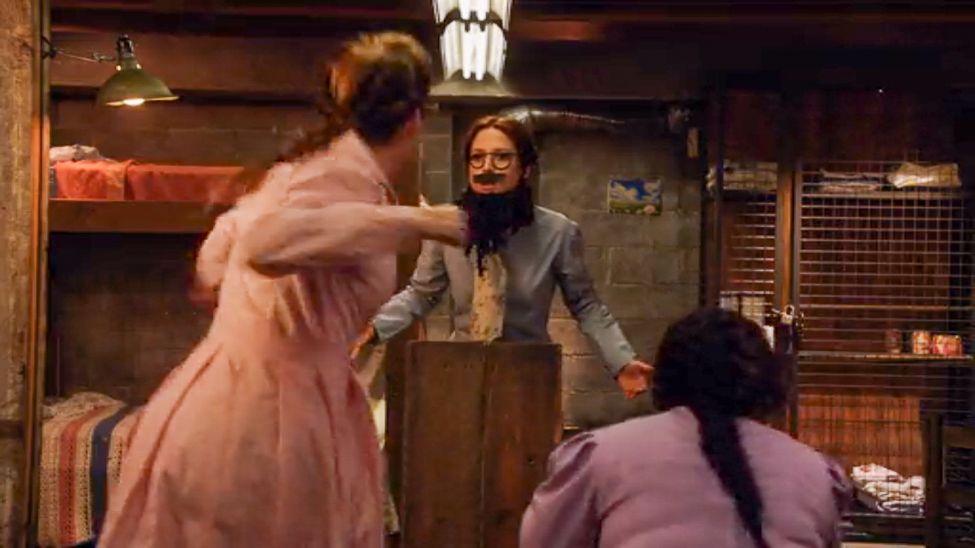
Longer than a cutaway flashback, storyteller flashbacks expand Kimmy’s backstory by providing a link between her past and present, but they primarily expose viewers to the memories that Kimmy has curated for herself. Storyteller flashbacks tend to showcase Kimmy’s strength in the bunker and orient audiences to perceive Kimmy as a survivor rather than a victim. This emphasis on Kimmy’s resilience invites viewers into a very different kind of engagement with a captivity narrative.
The dual narrative functions of storyteller flashbacks—to explain Kimmy’s past while simultaneously framing her as a resilient survivor—are established along with other series intrinsic norms in the first episode. After her money is stolen, Titus convinces Kimmy to give up and go back to Indiana. “Escaping is not the same as making it, Kimmy!” (“Kimmy Goes Outside!” 00:18:45-50). Demoralized, waiting at the bus station, she sees a rat rooting through the trash. While she stares at the rat thoughtfully, the audience hears the Reverend in voiceover, “I was talking to my good friend God…” and the scene visually shifts to a “bible study” in the bunker.
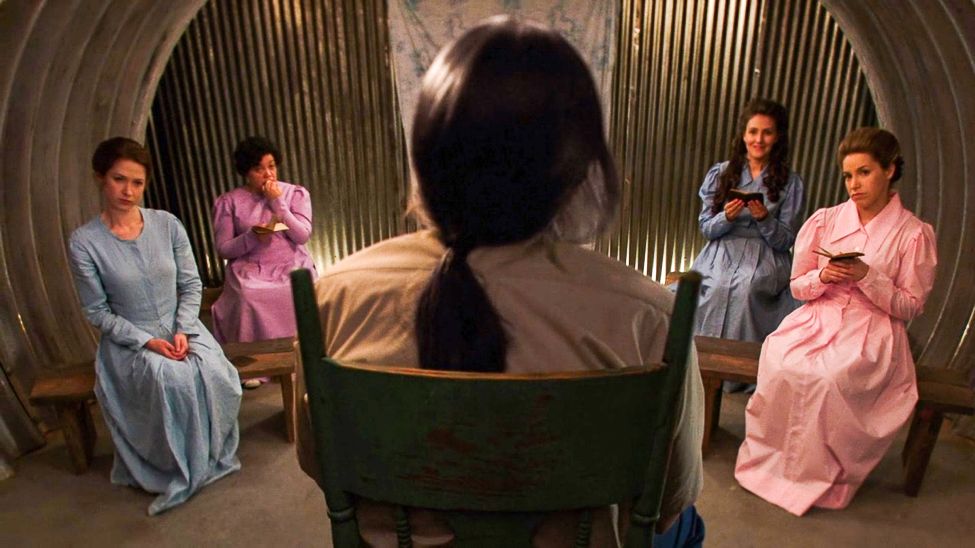
Kimmy, Cyndee, Donna Maria, and Gretchen (Lauren Adams) face the camera, and the Reverend faces them. The women are the focal point for the framing; the Reverend has his back to the camera, and he remains obscured for the entire flashback. Kimmy asks, “Reverend Richard, I was wondering—the whole world was destroyed, and everything died, right?” The Reverend replies, “Except for all you dumb dumbs here, yes.” Growing confident, Kimmy shouts, “Then, how come, when I was cleaning out the air filter earlier, I found THIS?!,” thrusting a squirming rat in the air.
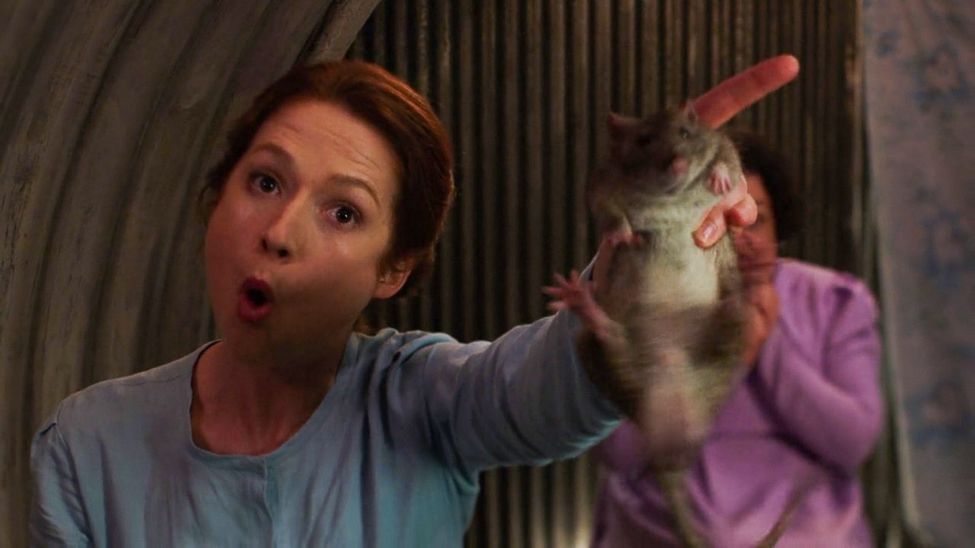
Donna Maria laughs, Gretchen and Cyndee are shocked, and the Reverend is furious. With the camera framing Kimmy’s defiant face, the Reverend says in voiceover, “Ew ew ew! Damn you Kimmy Schmidt! I will break you!” “No you won’t!” Kimmy replies, smiling (emphasis in original, “Kimmy Goes Outside!” 00:19:45-21:10). This storyteller flashback showcases a moment of Kimmy’s certainty and triumph over her captor. Revived by the memory, Kimmy decides to stay in New York, determined she can both escape and make it. Subsequent storyteller flashbacks in UKS continue this pattern of strategically integrating memories of resilience and strength from Kimmy’s captive past in ways that motivate her through difficult moments in her present.
The third category in the UKS flashback typology is the re-experiencing flashback. After a triggering action—usually a man who surprises or touches Kimmy—she reacts violently and physically overpowers the person who triggered the flashback. Though rare, re-experiencing flashbacks draw attention to the details of Kimmy’s experiences that are not available to viewers. We, the audience, can watch Kimmy experience this flashback in real (story) time, but the audience does not have access to Kimmy’s visual or auditory experiences during the flashback. Viewers do not enter Kimmy’s memories in a re-experiencing flashback as they do in cutaways or storyteller flashbacks; viewers can only watch as Kimmy struggles with the memory that they are prevented from seeing.
The most extensive re-experiencing flashback sequence in the series happens in the second season. Kimmy meets Keith (Sam Page), a combat veteran who approaches her in a bar and asks where she served. “You look like you’ve seen some stuff… you’re a survivor” (“Kimmy Walks Into a Bar!” 00:04:45-06:35). Kimmy plays along without sharing her traumatic details, desperate to connect yet unwilling to be branded a victim. Later in the episode, Keith joins Kimmy for a party at Jacqueline’s. Standing in the kitchen, they joke about what non-traumatized people find scary, like horror movies. Another guest knocks over a vase, triggering simultaneous PTSD-style re-experiencing flashbacks for Kimmy and Keith. Keith grabs Kimmy and pulls her to the floor while shouting “Incoming!” Kimmy reacts to Keith’s sudden physical touch by punching and twisting him into a headlock while shouting, “Let go of me old man!” They trade lines while grappling for dominance—“They’re inside the wire!” “I’m gonna rip your beard off!”—before they suddenly snap back to the party (“Kimmy Walks Into a Bar!” 00:24:25-25:00). It is a powerful, darkly comic visual—two attractive people in evening wear, physically locked together while trapped in separate traumatic flashbacks.

Viewers infer Kimmy is recalling a specific instance of the Reverend’s assault, but they are restricted from accessing the details of that assault—a restriction that prevents the possibility of voyeuristic or cathartic pleasure in the audience. In her analysis of Room, Thirteen, and UKS, Anna Leszkiewicz confronts the tricky pleasures available to viewers of captivity narratives:
When we view the girl suffering at the hands of her abuser, the male gaze functions in a specific voyeuristic way: the straight male viewer can both, on one level, distance himself from (and condemn the actions of) the abuser, pitying his victim, whilst simultaneously enjoying the on-screen depiction of transgressive sexual fantasies.
Refusing to depict Kimmy being abused rejects the potential for (even inadvertent) voyeuristic pleasure in response to her abuse.
Further, the series directly calls out audience expectations for cathartic release through captivity narratives in the dialogue. After Kimmy reveals her Mole Woman past in the first episode, Titus, concerned about their ability to pay rent, says, “I’m very scared to ask you this…” and Kimmy interrupts him with an exasperated, “Yes, there was weird sex stuff in the bunker,” one of her very few direct acknowledgements of rape (“Kimmy Goes Outside!” 00:18:50-19:00). In the third episode, Kimmy reprimands Titus soundly for his delighted/horrified reactions to any offhand bunker comment. Titus replies:
It’s not my fault. People love hearing terrible details of news tragedies. One: it’s titillating, like a horror movie. Two: It makes them feel like a good person, because they care about a stranger. Three: It makes people feel safe that it did not happen to them. (“Kimmy Goes on a Date!” 00:01:20-40)
By suppressing all the “titillating” details about “weird sex stuff,” UKS refuses audiences even the possibility of indulging in pleasure or horror, voyeurism or catharsis. The aftereffects of trauma are present throughout Kimmy’s life, but the viewer will never get the juicy, terrible details. Additionally, the campy exaggerations and tone throughout the series work to dethrone the serious and invite viewers into a more complex relationship with captivity survivors.
Contributing to this reorientation is the role the Reverend does not play in Kimmy’s flashbacks. Even when his proximity is indicated, he is not “present” in Kimmy’s flashbacks the way that Donna Maria, Gretchen, and Cyndee are. He is obscured by the framing, relegated to a disembodied voice, or entirely absent. The first time the audience sees the Reverend’s face is during his trial at the end of Season 1, when he charms and manipulates news reporters, the jury, and the courtroom in a campy exaggeration of tabloid-style media coverage. Acting as his own attorney, the Reverend is on the verge of acquittal when Kimmy finally returns to Durnsville to testify. While cross-examining Kimmy, the Revered triggers a diegetic retelling of his own: “Your honor, if it pleases the court, I would like everyone to close their eyes and join me in a flashback.” The jurors and spectators shrug, close their eyes, and participate in a communal storyteller flashback into the Reverend’s memory along with the viewing audience. The scene shifts to the bunker, where Kimmy has been operating the mystery crank for twenty-four hours as punishment for the rat incident. The Reverend threatens to throw her outside into the lake of fire to make her believe him. When she remains defiant, he changes tactics. “If you’re so sure of yourself, you won’t object if I send Sister Cyndee out into the wasteland?” He calls for Cyndee and unlocks the main door leading to the outside. “She trusts you. She counts on you to take care of her, especially since you cured her Hulkamania. So, as long as you’re absolutely sure…” Frightened, Kimmy shuts the door just as Cyndee arrives. The scene shifts back to the courthouse, where the Reverend is inappropriately sitting in the jury box with his arms draped around jurors. He casually offers the final argument in his case: “Ladies and gentlemen of the jury, clearly my client offered to let these women go. Kimmy Schmidt chose to stay. Now, if that’s kidnapping, lock me up and throw away the key!” (“Kimmy Goes to Court!” 00:10:45-14:00).
This is the first flashback to the bunker in which viewers see the Reverend’s face and actions in the bunker, and one of very few examples in the series of Kimmy acquiescing to the Reverend rather than resisting him. It is important to note that this is not Kimmy’s flashback—it is the Reverend’s. He is initiating, directing, and framing the flashback for viewers and characters in the courtroom alike. We see in this scene the mastery of the Reverend’s manipulations. Kimmy has no qualms about using herself as collateral, but she cannot bear to risk the life of someone she loves. He uses her willingness to protect to force her to surrender, even if he has not “broken” her the way he wanted. Additionally, viewers see that his campy “charm” sways those in the courtroom eager for titillating details of captivity that they can use to judge the victims, the details that Kimmy always keeps to herself.
Popular critical reviews of UKS often point to Kimmy’s relentless optimism as “a necessary façade for her inner pain” (Cruz), a coping mechanism where her positive thinking is “presented as a kind of resilience, helping her to get through long, boring, frightening days in the bunker” (Bernstein), even as viewers know “there’s also something tense and over-chipper about Kimmy’s zest, an artificial quality that even the cartoonish characters around her can sense is ‘off’” (Nussbaum). The series is framed as “a show about resilience, the strength of the human spirit in the face of tremendous adversity” (Kunst). Critics also point to the series’ embrace of both the dark and bright sides of life (Garber). Recapping the final half of the fourth season, Liz Shannon Miller captured the fine line on which the series balances:
Never being afraid of the premise’s innate darkness meant that whenever the story required it, “Unbreakable Kimmy Schmidt” would choose to honor Kimmy’s very real trauma over a happier or more comedic outcome. As dark as the show ever got, it never lost its core sense of optimism, that sense that no matter how bad things get, there’s always a chance to get better. (Miller)
The narrative techniques in UKS position Kimmy less as a relentless optimist, and more as a woman fiercely determined to reframe her experience and memories of reality. The coping strategies Kimmy devised in the bunker work to change the way she perceived reality in the face of unrelenting trauma. Kimmy’s habit of shifting reality—of seeing and remembering only what she wants to—carries into her post-captivity coping strategies, as demonstrated through her diegetic retellings of positive lessons and flashbacks to positive memories from the bunker. On the rare occasions in which Kimmy does have a PTSD-style, re-experiencing flashback, viewers cannot see her traumatic memories. Instead, they watch as Kimmy actively rewrites the ending to the memory by physically overpowering the person who triggered her flashback. If she tried to erase the bunker, she would erase herself. Instead, Kimmy’s selective memories work instead to erase the Reverend from the very bunker that he controlled while keeping the friendship and fantasy. Remembering her captivity as moments of strength instead of fear allows Kimmy to reframe and reconstruct her past actively, strengthening her self-image as a resilient survivor in ways that enhance her ability to cope with present challenges.
Likewise, UKS on the whole employs narrative techniques that invite audiences to see other captivity survivors as resilient and tenacious instead of seeing them as damaged, permanently traumatized women who have been “ruined” by an abusive man. UKS recognizes that women can become (in)famous because of the actions that men take against them, and that this is an intrinsic part of rape culture and broader misogynistic underpinnings of patriarchal power structures (Gay, Gilmore, Manne, Phillips). Rather than contribute to a culture that freezes images of women in their traumatic moments and normalizes that trauma through visual repetition, UKS instead mocks the perpetuation of rape culture in popular media by using campy, over-the-top comedy to deal with the darkness of captivity narratives. The series satirizes social norms about (im)perfect victims, and the high camp makes clear that the targets of this satire are broadly cultural. UKS rebuffs those who would approach survivors in narrow, judgmental ways or look for ways to paint them as unreliable witnesses to their own trauma. The series mocks the cultural constructions of “common sense” that work to justify the actions of (male) perpetrators while scrutinizing the actions of (female) victims (Gilmore, Manne). The narrative construction in UKS tightly controls the release of Kimmy’s memories and experiences to other characters as well as to the viewer, challenging the viewer’s sense of omniscience in the storyworld as well as storytelling traditions employing the male gaze that encourage audience identification with the male captor over the female captive (Mulvey). The series challenges viewers’ entitlement to and relationship with the traumatic details of captivity survival, ultimately inviting viewers into a more complex relationship with captivity survivors. UKS encourages audiences to see survivors as the centers of their own stories rather than as traumatized players in the abuser’s story. Because, ultimately, UKS argues and demonstrates that “females are strong as hell.”
Works Cited
Bernstein, Arielle. “The radical subversion of Unbreakable Kimmy Schmidt’s survival narrative.” The Guardian, 29 May 2018. https://www.theguardian.com/tv-and-radio/2018/may/29/unbreakable-kimmy-schmidt-radical-survival-narrative.
Bordwell, David. Narration in the Fiction Film. U Wisconsin P, 1990.
Cruz, Lenika. “Unbreakable Kimmy Schmidt and the Sunny Side of Surviving.” The Atlantic, 3 Mar. 2015. https://www.theatlantic.com/entertainment/archive/2015/03/unbreakable-kimmy-schmidt-enlightened-not-naive/385626/.
Coleman, Penny. Flashback: Posttraumatic Stress Disorder, Suicide, and the Lessons of War. Beacon, 2006.
Fey, Tina and Robert Carlock, creators. Unbreakable Kimmy Schmidt. Netflix, 2015-2019. https://www.netflix.com/title/80025384.
Garber, Megan. “Pop Culture’s Fascination with Captive Women.” The Atlantic, 6 July 2016. https://www.theatlantic.com/entertainment/archive/2016/07/pop-cultures-fascination-with-captive-women/490067/.
Gay, Roxanne, ed. Not That Bad: Dispatches from Rape Culture. Harper Perennial, 2018.
Gilmore, Leigh. Tainted Witness: Why We Doubt What Women Say About Their Lives. Columbia UP, 2017.
Herman, David, Manfred Jahn, and Marie-Laure Ryan. Routledge Encyclopedia of Narrative Theory. Routledge, 2005.
“Kimmy Gets a Job!” Unbreakable Kimmy Schmidt, season 1, episode 2, Netflix Original, 2015. Netflix, https://www.netflix.com/title/80025384.
“Kimmy Goes Outside!” Unbreakable Kimmy Schmidt, season 1, episode 1, Netflix Original, 2015. Netflix, https://www.netflix.com/title/80025384.
“Kimmy Goes to Court!” Unbreakable Kimmy Schmidt, season 1, episode 12, Netflix Original, 2015. Netflix, https://www.netflix.com/title/80025384.
“Kimmy Goes to Her Happy Place!” Unbreakable Kimmy Schmidt, season 2, episode 10, Netflix Original, 2016. Netflix, https://www.netflix.com/title/80025384.
“Kimmy Meets a Drunk Lady!” Unbreakable Kimmy Schmidt, season 2, episode 9, Netflix Original, 2016. Netflix, https://www.netflix.com/title/80025384.
“Kimmy Meets an Old Friend!” Unbreakable Kimmy Schmidt, season 4, episode 6, Netflix Original, 2018. Netflix, https://www.netflix.com/title/80025384.
“Kimmy Walks Into a Bar!” Unbreakable Kimmy Schmidt, season 2, episode 7, Netflix Original, 2016. Netflix, https://www.netflix.com/title/80025384.
“Kimmy Says Bye!” Unbreakable Kimmy Schmidt, season 4, episode 12, Netflix Original, 2019. Netflix, https://www.netflix.com/title/80025384.
Kunst, Jennifer. “Lessons from the Unbreakable Kimmy Schmidt: How to fix your problems from the inside-out.” Psychology Today, 22 Apr. 2015. https://www.psychologytoday.com/us/blog/headshrinkers-guide-the-galaxy/201504/lessons-the-unbreakable-kimmy-schmidt.
Leszkiewicz, Anna. “Lost and Found: Why are we obsessed with stories of young women escaping their kidnappers?” New Statesman America, 12 Apr. 2016. https://www.newstatesman.com/culture/tv-radio/2016/04/lost-and-found-why-are-we-obsessed-stories-young-women-escaping-their.
Manne, Kate. Down Girl: The Logic of Misogyny. Oxford UP, 2018.
Miller, Liz Shannon. “’Unbreakable Kimmy Schmidt’ Review: A rushed goodbye, but a perfect ending.” IndieWire, 25 Jan. 2019. https://www.indiewire.com/2019/01/unbreakable-kimmy-schmidt-season-4-review-series-finale-ending-spoilers-1202038348/.
Mittell, Jason. Complex TV: The Poetics of Contemporary Television. New York UP, 2015.
Nussbaum, Emily. “Candy Girl: The bright-pink resilience of ‘Unbreakable Kimmy Schmidt.’” The New Yorker, 30 Mar. 2015. https://www.newyorker.com/magazine/2015/03/30/candy-girl.
Phillips, Nickie D. Beyond Blurred Lines: Rape Culture in Popular Media. Rowman & Littlefield, 2017.
Posttraumatic Stress Disorder. American Psychiatric Association, 2013. https://www.psychiatry.org/File%20Library/Psychiatrists/Practice/DSM/APA_DSM-5-PTSD.pdf.
Richmond, Jeff. “Unbreakable Kimmy Schmidt Opening Theme,” Netflix. YouTube, uploaded by Netflix on 24 Mar. 2015, https://www.youtube.com/watch?v=LIdFa1qLgNQ.
Sontag, Susan. “Notes on Camp,” Partisan Review, vol. 31, no. 4, 1964, pp. 515-530. Howard Gotlieb Archival Research Center, Boston University, hgar-srv3.bu.edu/collections/partisan-review/search/detail?id=326066.
“Unbreakable Kimmy Schmidt: Ding-Dong Diddly, Ding-Dong Do. Kimmy’s Happy Place Song.” TV Guide, uploaded 26 Apr. 2016, https://www.tvguide.com/videos/play/unbreakable-kimmy-schmidt-ding-dong-diddly-ding-dong-do/.

